Recreating 1836..........
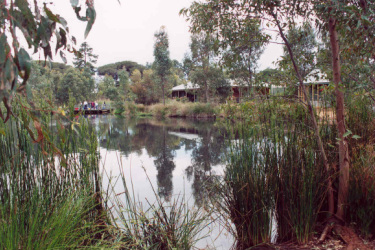
The land scape surrounding the Urrbrae Wetland has been revegetated with a wide variety of native plants, all propagated from local species which would be found growing in a Grey Grassy Woodland habitat. This was done to recreate the area as it might have looked like prior to European Settlement in 1836.
Some of the species that have been planted to recreate the Grey Grassy Woodland habitat are:
Canopy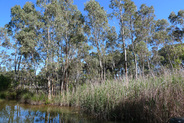
- Grey Box (Eucaluptus microcarpa) - South Australian Blue Gum (Eucalyptus leucoxylon) - *River Red Gum (Eucalyptus camaldulensis) - *Drooping Sheoak (Allocasurina verticillata)
|
Under Story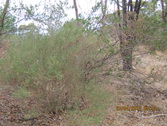
- *Sweet Bursaria (Bursaria spinosa) - *Golden Wattle (Acacia pycnantha) - Kangaroo Thorn (Acacia paradoxa) - Sticky Hop bush (Dodonaea viscosa) - Native apricot (Pittosporum phylliraeoides) - Round Leaf Wattle (Acacia acinacia)
|
Ground Cover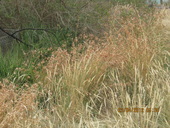
- *Native lilac (Hardenbergia violacea) - *Kangaroo Grass (Themeda triandra) - *Elegant Spear Grass (Austrostipa elegantissima) - *Ruby Saltbush (Enchylaena tomentosa) - Fuzzy New Holland Daisy (Vittsdinia cufleata) - *Sweet Apple Berry (Billardiera cymosa)
|
Aquatic Zone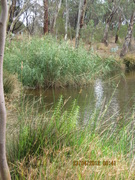
- *Common reed (Phragmites australis) - Sea Rush (Juncus kraussii) - *Spiny Flat Sedge (Cypers gymnocaulos) - Stiff Flat Sedge (Cyprus vaginatus) These plants play a key role in: --- Reducing water velocity ---Removing nutrients ---Oxygenating the water ---Providing food and shelter | ||||||||||||||||||||||||||||||||||||||||||||||||||||||||||||||||||||||||||||||||||||||||||||||||||||||||||||||||||||||||||||||||||||||||||
* Represents plants featured along the Indigenous Plant Trail, and were an important resource to the Aboriginal People.
Incorporate a native flora into your Curriculum, with a trip to the Urrbrae Wetland
Habitat Surveys
The Urrbrae Wetland is a unique place to study native flora because it incorporates a wide range of ecosystems and vegetation types. This allows students to conduct habitat surveys in riparian and in stream zones, where they investigate the health of the verge, bank and ephemeral vegetation and the in stream cover. Following this they are able to give an overall score and assess which areas of the Urrbrae Wetland provide the best habitat.
The Urrbrae Wetland is a unique place to study native flora because it incorporates a wide range of ecosystems and vegetation types. This allows students to conduct habitat surveys in riparian and in stream zones, where they investigate the health of the verge, bank and ephemeral vegetation and the in stream cover. Following this they are able to give an overall score and assess which areas of the Urrbrae Wetland provide the best habitat.
| wetland_habitat_survey.docx | |
| File Size: | 595 kb |
| File Type: | docx |
Terrestrial Plants
Plants are interesting and marvellous organisms to as they cannot run away, do not bite and don't get too stressed when you study them. Here at the Urrbrae Wetland there many activities centred around the native flora, including:
- Willows vs Redgums - students investigate the positive and negatives of each species in an aquatic ecosystem.
- Plant Identification - students identify plant species by looking at numerous aspects including their flower, fruit, leaves and structure.
- Abiotic and biotic influences on plants - students investigate the abiotic and biotic factors that influence distribution.
- How do seeds travel - students investigate the clever and wonderful ways that plant disperse their seeds.
- Love, Hate Relationships - students investigate different relationships between insects and plants including galls, lurps, and leaf cutters.
- Willows vs Redgums - students investigate the positive and negatives of each species in an aquatic ecosystem.
- Plant Identification - students identify plant species by looking at numerous aspects including their flower, fruit, leaves and structure.
- Abiotic and biotic influences on plants - students investigate the abiotic and biotic factors that influence distribution.
- How do seeds travel - students investigate the clever and wonderful ways that plant disperse their seeds.
- Love, Hate Relationships - students investigate different relationships between insects and plants including galls, lurps, and leaf cutters.
Aquatic Plants
When the word "ALGAE" is used it often creates a negative response by people. However a trip to the wetland may just change this response, as students learn why algae is one of the most important living organisms on earth.
| micro_organisms.docx | |
| File Size: | 107 kb |
| File Type: | docx |
To find our more on how The Urrbrae Wetland Facility can assist you in achieving outcomes based around native flora, simply contact the Wetland Manager.
